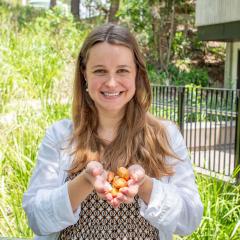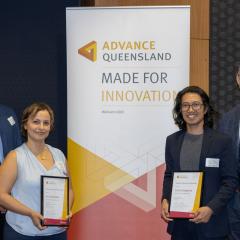New research in Queensland aims to improve mungbean yields in an increasingly variable climate. It will also provide essential information about the key factors influencing plant growth and yields.
Mungbean (Vigna radiata) is a high-value summer legume crop, returning an average of $1100 per tonne to growers. As a legume, it has the ability to fix nitrogen and improve soil productivity, which makes it an attractive option for growers in Queensland and northern NSW.
It is a valuable export crop for Australia. The average annual production over the past five years has been 90,000 tonnes, according to the Australian Mungbean Association (AMA), and 90 per cent of the crop is exported.

At the University of Queensland, Geetika Geetika is focused on identifying the traits that limit mungbean yields. As part of her PhD research for the Queensland Alliance of Agriculture and Food Innovation (QAAFI) Geetika aims to improve the overall understanding of crop physiology, improve the consistency of crop production and, ultimately, help lift Australia’s average yield from one to 1.5 tonnes/hectare.
Yields can range from bumper crops of up to three tonnes down to as little as 0.2 tonnes, depending on seasonal influences, such as the timing of extreme temperatures or lack of rain. Good yields to date have largely been reliant on good seasonal conditions.
Her research is part of a five-year GRDC collaboration, ‘Optimising Mungbean Yields’, which runs until 2023, with Associate Professor Rao (RCN) Rachaputi as her supervisor.
The PhD project spans the crop’s canopy development and phenology; vegetative biomass accumulation, canopy light capture and reproductive growth; and genotype differences in plant physiology. This broad scope reflects the shortfall in the current biological understanding of the plant’s lifecycle.
Geetika’s findings are expected to help direct plant breeding efforts and identify management strategies that growers can use to improve yields.
 Mungbean development
Mungbean development
In experiments in the 2018–2019 summer, she examined the crop phenology and pod development of five mungbean cultivars and a variety from a related crop species known as black gram or mungo bean (Vigna mungo).
The mungbean cultivars were Berken, Celera II-AU, Jade-AU, Satin II, and Opal-AU. The black gram variety was Onyx-AU.
Preliminary findings from the trial have brought the crop’s critical developmental phases into sharp focus, helping identify the plant’s source-sink relationship – the movement of photosynthetic products from regions of supply (source), such as leaves, to regions of use or storage (sink), such as grain.
“Flowering and pod development influence the plant’s source-sink relationships,” Geetika says. She found that mungbeans tend to rapidly flower and pod, and stop producing leaves on the plant’s main stem during these reproductive growth stages.
This could be linked to the ‘determinate’ growth of mungbean – leaf production on the main stem stops once the plant achieves a genetically predetermined stage of development, she says.
“The last (trifoliate) leaf formed on the main stem of mungbean plants was smaller than the others, and the plant’s growing tip, or apical meristem, develops into a flower bud.”

Vegetative biomass
Geetika has also investigated how the accumulation of vegetative biomass might influence mungbean yields. Vegetative biomass was assessed based on the crop canopy’s ability to capture light.
Different types of crop canopies create different gradients of the light extinction coefficient and light use efficiency that shape vegetative growth. This growth determines how much light plants can receive and convert into biomass.
“Increased biomass production is linked to improved light capture in crops,” Geetika says.
Mungbean is typically sown on 0.5 to 1 metre row spacing using varying plant population densities. However, mungbeans sown on narrower row spacings tend to produce more vegetative biomass and have higher yield potential due to improved light capture.

Canopy density
Geetika tested the yield impacts of crop canopy density in paddock trials at the University of Queensland’s Gatton campus in 2019 and 2020.
Jade-AU and Satin II mungbean varieties were sown on narrow 0.5 metre row-spacings at a rate of 22 plants per square metre to promote high canopy density. These varieties were also sown on wide 1 metre row spacings at a relatively low rate of 12 plants/m2 to promote low canopy density. A third experiment looked at the yield effects of a high plant population (33 plants/m2) on both narrow and wide row spacings.
The trials found the Jade-AU variety had a slight yield advantage over Satin II, even though its crop canopy intercepted less light. Geetika says the higher yield appears to stem from Jade-AU’s higher radiation use efficiency, as opposed to its canopy light capture.
“This may assist it to more efficiently produce assimilates (photosynthetic products) for use by developing pods, resulting in higher yields,” she says.

Source-sink influence
Another strand of the PhD research is investigating how the source-sink relationship in mungbean plants drives crop yields.
She has established an experiment to explore whether yield is limited by assimilate production in leaves (source limitation), using shade cloth to reduce light on mungbean crops at different growth stages.
Geetika is also developing new equations, drawing on her experiment findings, to facilitate improved crop modelling and simulation. For instance, these equations will be used to simulate mungbean growth, development and yield using the Agricultural Production Systems sIMulator (APSIM).
Geetika PhD is funded by the Grains Research and Development Corporation and The University of Queensland and the Department of Agriculture and Fisheries Queensland.
Research contacts: Ms Geetika Geetika, PhD candidate, Centre for Crop Science, Queensland Alliance for Agriculture and Food Innovation (QAAFI), The University of Queensland, M. 0481 266 089 E. g.geetika@uq.edu.au or Associate Professor Rao (RCN) Rachaputi, Principal Research Fellow (Grain Legumes), QAAFI at UQ Gatton T. + 61 7 5351 5093 or M. 0427 600 737, E. rao.rachaputi@uq.edu.au
Media contact: Carolyn Martin, QAAFI Communications, E. carolyn.martin@uq.edu.au M. 0439 399 886
High-resolution photos: credit (supplied @qaafi)
The Queensland Alliance for Agriculture and Food Innovation is a research institute at The University of Queensland supported by the Queensland Government via the Queensland Department of Agriculture and Fisheries.



